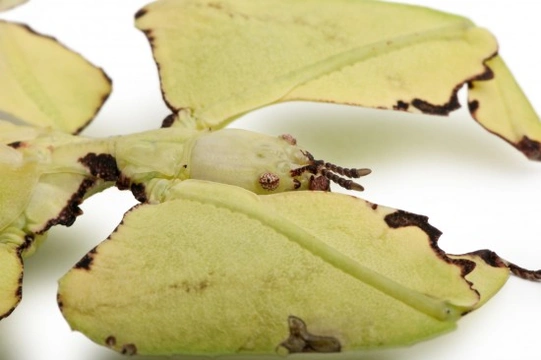
Keeping a pet leaf insect
The leaf insect (Phyllium philippinicus) is a species of stick insect that is usually a bright, vibrant green in colouration and looks just like a leaf! They even have light brown lines around the borders of their bodies, which help to perpetuate this illusion. They are one of the more popular pet insect species, along with the giant leaf insect that is similar (but larger) and offer a little variety to the regular stick insect, which appears rather dull in appearance by comparison!
They are native to the Philippines, and widely bred in captivity across the world (including the UK) for the pet trade.
If you are looking for a good starter insect to keep as a pet, or a low maintenance, educational animal to help to teach your children about nature and pet care, read on to learn more about the leaf insect.
Appearance and behaviour
The easiest way to describe the appearance of a leaf insect is to say that they look just like a leaf, and can often be mistaken for the foliage surrounding them, which is part of their camouflage-based defensive structure. They have a broad but flat body, and are generally green in colouration with brown markings and spots, although variants in browns and even pink hues are also available. They grow to around 6 or 7cm long, with females being slightly larger than males.
Telling the difference between male and female leaf insects is relatively simple; the females are larger and broader, with large wings that lie along the length of the body, but not the secondary set of under wings that are necessary for actual flight. Males can fly when fully grown, and have antennae that are much longer than that of females.
Leaf insects are largely nocturnal, so are likely to be fairly inactive during the day. You may not be able to spot your leaf insects moving at all (or be able to identify them within the tank)! during daylight hours, although you should be able to see them moving around at night.
Leaf insects are fairly social creatures, and may be kept in pairs and groups in a tank that is large enough to comfortably house them. Unfortunately, leaf insects cannot be kept together with stick insects, as stick insects may try to eat your leaf insects!
Housing and environment
Housing leaf insects is fairly straightforward, and they can comfortably live in either a glass or plastic tank such as an empty fish tank, or even a makeshift alternative plastic container such as a large sweetshop jar. The enclosure should be a bare minimum of three times the length of the fully-grown insect and two times the full length of the insect in depth and width. A larger container will of course be required to keep more than one leaf insect.
You will also need to provide a suitable substrate for the tank, such as a thin layer of organic peat or bark, and plenty of sticks, twigs and leaves such as blackberry leaves (bramble bushes) which are one of their favourites!
Condensation build-up can be a problem for leaf insects, and so it is better to cover the top or entrance to the tank with mesh or netting rather than a tightly fitting lid, to minimise the build-up of condensation. While condensation and running water within the tank is an issue, leaf insects do require relatively high humidity levels, and a moist substrate, but it is important to ensure that mould or fungus is not permitted to grow within the tank.
The temperature of the tank itself needs to be kept between 25 and 30 degrees Celsius, so a heat mat with a thermostat is recommended to ensure that the temperature is kept stable and warm enough for your pets.
Feeding leaf insects
Leaf insects are easy to feed, and will eat bramble leaves, rose leaves and oak leaves. These must always be fresh and replaced regularly, so ensure that you have access to a source of some of these leaf types before planning on setting up your tank! Smaller and juvenile leaf insects cannot eat from a full size, undamaged leaf, so you may need to tear the edges of the leaves or cut them up in order to feed smaller leaf insects (which are known as nymphs).
Water to drink is of course necessary for leaf insects, but these delicate creatures can soon drown in a dish of water or even in large droplets of water on their leaves and twigs. The best way to provide for your leaf insects’ water intake is by spraying the leaves and substrate of the tank lightly on a daily basis, which is necessary to maintain the optimum humidity level of the tank as well.
Where to buy leaf insects
Exotic pet shops and even some mainstream pet shops commonly keep insects such as leaf insects, and they are easy to breed in captivity. As a result of this, private sellers and hobbyist breeders often offer leaf insects for sale; check out thestick insectssectionhere on Pets4homes to see if any are available near you.



